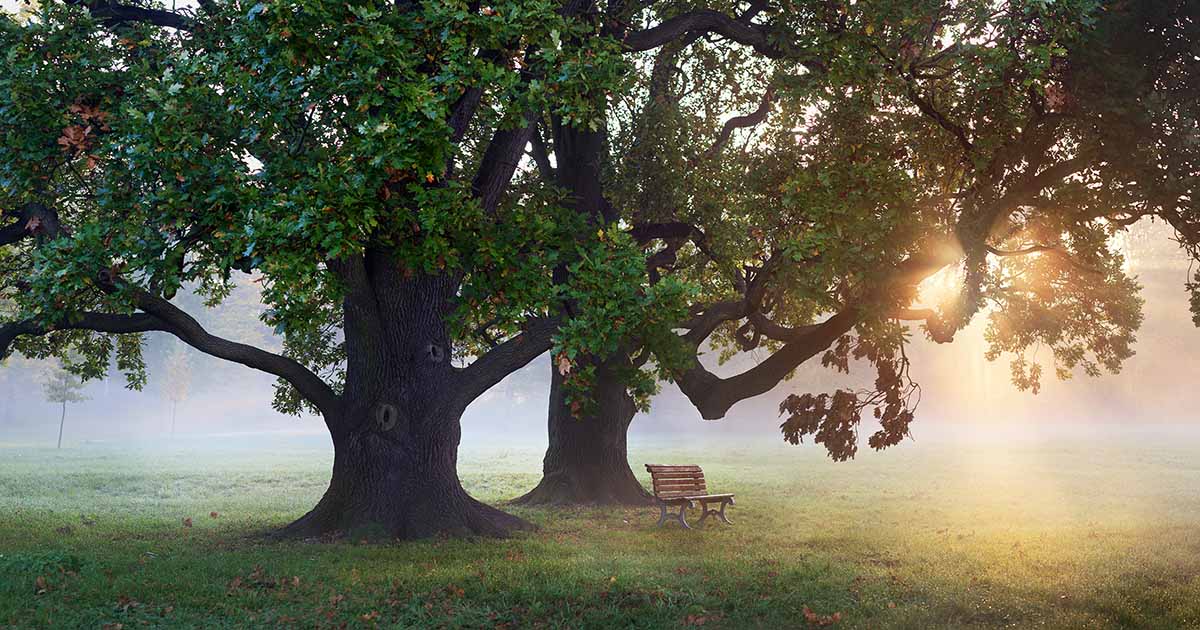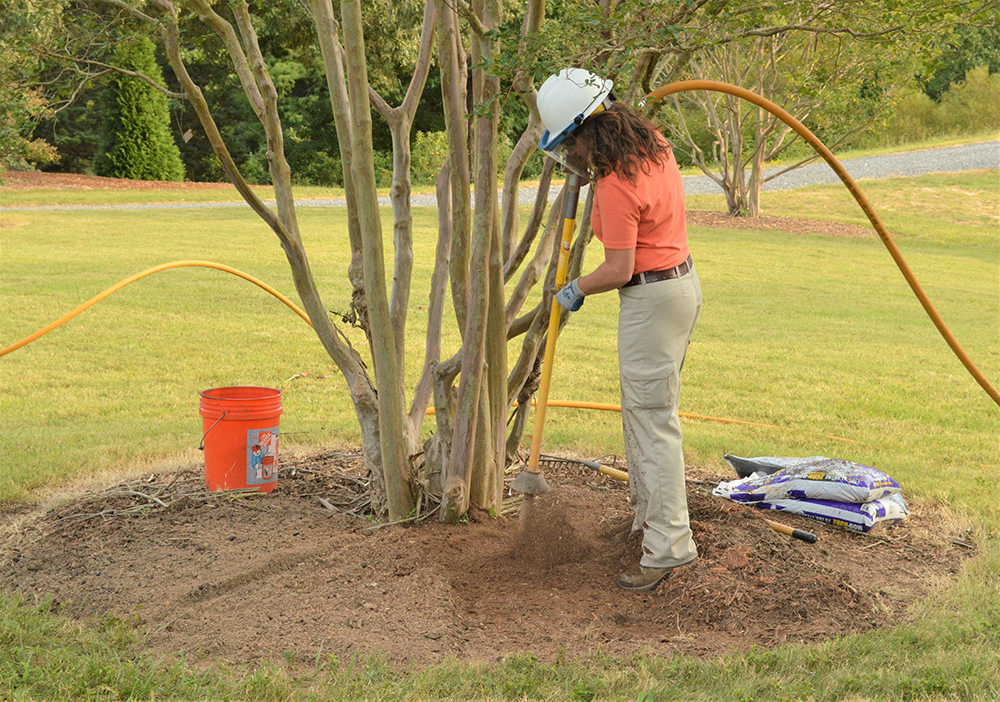
How to Make an Oak Tree Grow Faster and Thicker: 5 Tips for Improving the Growth Rate
Oak trees are one of the most popular trees to plant in North America. They are known for their strength, durability, and beauty. Many people choose to plant oak trees because they want a tree that will grow quickly and provide them with shade and privacy.
While there are no guarantees when it comes to how fast an oak tree will grow, there are some things you can do to help your tree grow as quickly as possible.
- Select a healthy oak tree sapling from a nursery or garden center
- Plant the sapling in well-draining, nutrient-rich soil in an area of your yard that receives full sun exposure
- Water the sapling deeply and regularly during its first growing season, keeping the soil moist but not soggy
- Fertilize the oak tree once per month during its first year with a balanced fertilizer formulated for trees and shrubs
- Prune any dead or damaged branches from the oak tree as needed to encourage new growth
Importance of Oak Trees
The majesticoak treeholds immense ecological importance. Not only do they symbolize strength and endurance, they also provide habitat for numerous species and improve air quality by sequestering carbon dioxide.
Benefits of Fast and Thick Oak Tree Growth
Improve Landscape Appearance:Thick, fast-growing oak trees provide aesthetic value to landscapes. They can be used as focal points in gardens or for privacy.
Enhance Biodiversity:Rapid growth helps oak trees reach their full potential sooner, providing habitat and food for wildlife quickly.
Increase Carbon Sequestration:A faster-growing tree absorbs carbon at a higher rate, contributing more to climate change mitigation.
Bolster Wood Supply:For timber production, faster growth results in quicker planting and harvesting cycles.
Promote Soil Health:Thick oak trees with vast root systems contribute significantly to soil health and fertility.
You can enhance your oak tree’s growth speed and thickness by employing effective strategies such as choosing the right species, location, and appropriate care.

Choose the Right Oak Tree Species
Regarding quick growth and thicker trunks, not alloak treespecies are made equal. Selecting an appropriate species is critical to boost your oak tree’s growth speed.
Best Oak Tree Species for Fast Growth
Certain oak tree species, such as Northern Red Oak and Pin Oak, grow faster than others. These species mature quickly and develop thicker trunks, enhancing the overall aesthetics of your landscape.
Factors to Consider When Choosing an Oak Tree
It’s not just about speed and thickness; consider factors like local climate, soil conditions, available space, and the tree’s resistance to pests and diseases. Big trees need room to grow; some species prefer sandy or clay soil, and specific climates influence the oak tree growth rate.
Oaktree saplings can be vital to consider. Learn how:
Proper Planting Techniques
A critical aspect of accelerating the growth rate of anoak treeis paying attention to the planting techniques.
Selecting a Suitable Planting Site
Location Matters:The oak tree needs ample sunlight and well-drained soil. Pick a sunny spot with room for growth to prevent stifling your tree.
Preparing the Soil for Planting
Prepare the Ground:Prepare the soil by removing any weeds and adding compost if necessary. Consider testing the soil pH level to ensure it’s optimal for oak growth.
Planting and Watering Instructions
Action:Water thoroughly and regularly after planting, particularly during dry spells. This helps the oak tree to establish a deep root system for rapid, healthy growth.

Adequate Watering and Fertilizing
To boost the growth rate of oak trees, it’s crucial to implement some basic yet essential routines. Here are two cogent ones.
Proper Watering Techniques
Watering is pivotal for the healthy growth of anoak tree. Provide deep and infrequent watering to foster root development, compared to frequent shallow watering, which may lead to root-shallowing. Aim to water about once a week or whenever the soil feels dry, about 2-3 inches under the surface.
Fertilizing Oak Trees for Growth Enhancement
Fertilization is key for an oak tree’s faster and thicker growth. Opt for a balanced, tree-specific fertilizer. Assess the soil’s nutrients yearly and supplement any deficiencies with appropriate fertilizers. This ensures your tree gets the essential elements needed for its optimal growth.

Pruning and Trimming
Oak trees are a magnificent addition to your landscape, but proper care is essential for them to grow thicker and faster. One critical activity is regularpruningand trimming.
Importance of Pruning for Oak Tree Growth
Oaktree health:Pruning plays a pivotal role in promoting oak tree health. Removing dead, diseased, or damaged branches effectively reduces the chances of spreading disease and infestation by pests.
Techniques for Pruning Oak Trees
Create a plan:Before embarking on pruning, assess your tree carefully. Identify problematic areas that need addressing, such as low-lying or overlapping branches.
Clean cuts:When pruning, ensure all cuts are clean and in the right places to minimize damage to the tree. Cut close to the branch collar without leaving any stubs.
Strategic pruning initiatives can yield impressive growth results, setting your oak tree on a path toward fast, healthy development.

Protection from Pests and Diseases
Oak Trees are subject to various pests and diseases that can hamper their growth and development. Adopting early preventive measures and timely treatment options could enhance their health and ensure quicker, thicker growth.
Common Pests and Diseases Affecting Oak Trees
Oak trees are susceptible to pests and diseases, such as Oak Wilt, Anthracnose, and pests like Gypsy Moth Caterpillars. These infestations can cause damage ranging from aesthetic issues to tree death.
Preventive Measures and Treatment Options
Frequent inspectionsto detect early signs of infestation or disease,proper watering and fertilization, andprofessional arborist consultationsfor specific treatments are some ways to protect your oak trees from pests and diseases.Integrated Pest Management (IPM)strategies can also make oak trees grow faster and thicker.

Maintaining Soil Moisture and Nutrient Levels
The ideal growth of anOak treeisn’t just about planting it but also maintaining the environment in which it grows. This consists of managing soil moisture and nutrient levels effectively.
Mulching Techniques for Moisture Retention
Preserve water:Mulching involves applying organic matter around the base of your Oak tree. It works wonderfully in retaining soil’s moisture, providing a more favorable environment for your Oak tree to grow faster and thicker.
Soil Testing and Nutrient Management
Optimize nutrition:Don’t guess, soil test! By testing the nutrient content of your soil, you can accurately add required nutrients and thereby boost the growth rate of your oak tree. This proactive approach to nutrient management ensures your Oak grows healthy and strong.

Regular Monitoring and Care
Growing a sturdy and fast-growing oak tree requires regular monitoring and care. This care includes understanding your tree’s needs, identifying commontree diseases, and tailoring your care practices accordingly.
Observing and Addressing Signs of Stress or Damage
Stay Vigilant:Immediate attention to signs of stress like wilting leaves, disease, or pest infestation is crucial. Taking steps to address these issues ensures your oak tree’s growth and overall health.
Regular Maintenance Practices for Healthy Growth
Maintain Regularly:To amplify the growth rate, use consistent watering, annual pruning, soil testing & amendment, and using mulch around the base to retain moisture and control weeds. This set of interventions will promote healthy, faster-growing, and thicker oak trees.

What Fertilizer is Best for Oak Trees?
Many different types of fertilizer can be used on oak trees, but not all are created equal. Generally, it’s best to use a fertilizer that is high in nitrogen and low in phosphorus. This will help encourage growth without causing too much stress on the tree.
Additionally, make sure to choose a fertilizer specifically designed for use on oak trees – using the wrong type of fertilizer can do more harm than good. When applying fertilizer, always follow the instructions on the package carefully. Over-fertilizing can damage the roots and lead to other problems, so it’s essential to be cautious.
Generally, it’s best to fertilize oak trees twice per year – once in the spring and once in the fall. This will boost them when they need it most and help them stay healthy throughout the year.
How Fast Does an Oak Tree Grow Per Year?
Oak trees are one of the fastest-growing tree species in North America. They can grow up to 24 inches per year or 2 feet per year.
How Tall Will an Oak Tree Grow in 10 Years?
Assuming you are asking about the average height an oak tree will grow in 10 years, the answer is around 24 inches. This depends on the species of oak tree, as well as the growing conditions. For example, if the oak tree is grown in ideal conditions, it may be able to reach up to 36 inches in 10 years.
How Big is a 10-Year-Old Oak Tree?
When it comes to oak trees, there is no definitive answer to how big they can grow. This is because there are many different types of oak trees, each with its own growth potential. For example, the white oak can grow to be over 100 feet tall, while the dwarf oak only reaches a height of about 15 feet.
Generally speaking, though, most 10-year-old oak trees will be between 30 and 50 feet tall. So if you’re looking at an oak tree that’s around 10 years old and wondering how big it might be, it will fall somewhere within this range.
5 Year Old Oak Tree Size
Assuming you are talking about the average size of an oak tree, they can range anywhere from 40 to 80 feet. The average 5-year-old oak tree will be between 15 and 30 feet tall. These trees can live up to 500 years old, so they really are a lifelong investment.
How Fast Do Oak Trees Grow
Oak trees are one of the most popular types of trees in North America. They are known for their strength, durability, and beautiful fall foliage. But how fast do oak trees grow?
Oak trees can grow quite quickly, depending on the species and the growing conditions. In general, oak trees can grow up to 24 inches per year. However, some species of oak tree can grow even faster than that.
For example, the white oak can grow up to 36 inches per year. Of course, not all oaks will reach their maximum growth potential. Factors such as soil quality, water availability, and temperature can all affect how fast an oak tree grows.
Nevertheless, if you have a healthy oak tree in your yard, you can expect it to add several inches of growth each year.
How Fast Do Live Oaks Grow in Texas
In Texas, live oaks are one of the most popular trees to plant. They are known for their long life span and ability to withstand drought. However, many people are unaware of how fast these trees can grow.
On average, live oaks in Texas will grow about two feet yearly. This means that a live oak can easily be over 20 feet tall within ten years. Of course, this growth rate will vary depending on the location and climate conditions.
In some areas of Texas, live oaks can grow even faster – up to three or four feet per year! While the fast growth rate of live oaks is impressive, it’s important to remember that these trees take a long time to reach maturity. A live oak can take 50 to 150 years to reach its full potential size.
So if you’re looking for instant gratification, planting a live oak may not be the best option. But if you’re patient and willing to wait, you’ll be rewarded with a beautiful tree that will provide shade and enjoyment for generations to come.
Frequently Asked Questions:
Is oak a strong wood?
Yes, oak is generally considered a strong and durable wood. It is known for its hardness and strength, which makes it a popular choice for a wide range of woodworking projects, including furniture, flooring, cabinetry, and more. Oak is valued not only for its strength but also for its attractive grain patterns and ability to take stains and finishes well. There are different species of oak, with red oak and white oak being two common varieties used in woodworking. Both red and white oak are known for their strength and durability, but white oak is often considered slightly denser and more durable than red oak. However, both types of oak are strong and suitable for various applications.
Which is the strongest wood?
Lignum Vitae: Lignum vitae, native to the Caribbean and northern South America, is often considered one of the hardest and densest woods in the world. It has exceptional strength and durability and is used for applications like shipbuilding, bearings, and mallet heads.
Quebracho: Quebracho, found in South America, is incredibly dense and strong. It’s known for its hardness and is used for flooring and tool handles.
Ipe (Brazilian Walnut): Ipe is a South American hardwood known for its remarkable strength and durability. It’s often used in outdoor applications such as decking and boardwalks.
What is the weakest wood?
Balsa wood is one of the weakest and least dense woods commonly used in woodworking. It is known for its lightweight and soft characteristics, which make it unsuitable for applications that require strength or durability. Balsa wood is often used for crafting, model building, and other projects where its lightness is an advantage rather than a weakness.
Conclusion
The path to having a lush, thick oak tree doesn’t have to be complicated. Following these simple tips can expedite the growth rate of your tree.
Summary of Tips for Fast and Thick Oak Tree Growth
- Planting in the appropriate season
- Using the right soil mix
- Regular watering but avoiding waterlogged conditions
- Pruning unnecessary branches
- Use of targeted fertilizers.
These are practical steps to encourage both thicker and faster growth, ensuring your oak tree reaches its full potential.
Remember, consistency is key. For additional guidance, consider checking out the Oak Treegrowth resources available. Happy gardening!
Related Articles:
10 Best Small Evergreen Trees with Non Invasive Roots
 Dr Ahsanur Rahman, PHD
Dr Ahsanur Rahman, PHDPine Tree Rescue: Saving Pine Trees with Brown Needles
 Dr Ahsanur Rahman, PHD
Dr Ahsanur Rahman, PHD




